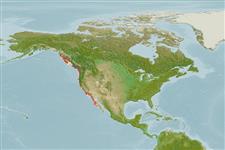Environment: milieu / climate zone / depth range / distribution range
Écologie
marin benthopélagique; profondeur 0 - 30 m (Ref. 6885). Temperate; 59°N - 14°N, 136°W - 93°W
Eastern Pacific: Sitka, Alaska to Punta Banda, northern Baja California, Mexico.
Taille / Poids / Âge
Maturity: Lm ? range ? - ? cm
Max length : 18.0 cm TL mâle / non sexé; (Ref. 2850); âge max. reporté: 9 années (Ref. 56049)
Description synthétique
Clés d'identification | Morphologie | Morphométrie
Épines dorsales (Total) : 24 - 27; Rayons mous dorsaux (Total) : 9 - 10; Épines anales: 1; Rayons mous anaux: 9. Spinous dorsal represented by a series of small spines, free from membrane; soft dorsal fin triangular and placed well back on body; caudal fin small and finely forked; anal fin spine small and broad, the fin mirroring the soft dorsal fin; pectorals truncate (Ref. 6885). Pale mottled brown, varying from olive green to yellow brown dorsally; creamy white ventrally; a bright silvery patch between operculum and pectorals extending to throat and bounded above by a dark band that extends forward through eye to snout; breeding males with bright red snout and phosphorescent snout (Ref. 6885).
Found in kelp beds, eelgrass, rocky areas, and over sand bottoms (Ref. 2850). Usually near the surface in schools, sometimes in dense schools well offshore (Ref. 2850). Feeds on small crustaceans and fish larvae (Ref. 6885). Minimum depth reported taken from Ref. 57178.
Nest is built, usually in kelp. Males are territorial (Ref. 6885) and guard the nest.
Eschmeyer, W.N., E.S. Herald and H. Hammann, 1983. A field guide to Pacific coast fishes of North America. Boston (MA, USA): Houghton Mifflin Company. xii+336 p. (Ref. 2850)
Statut dans la liste rouge de l'IUCN (Ref. 130435)
Menace pour l'homme
Harmless
Utilisations par l'homme
Pêcheries: commercial; Aquarium: Aquariums publics
Outils
Articles particuliers
Télécharger en XML
Sources Internet
Estimates based on models
Preferred temperature (Ref.
123201): 8.9 - 17.3, mean 10.4 °C (based on 184 cells).
Phylogenetic diversity index (Ref.
82804): PD
50 = 1.5000 [Uniqueness, from 0.5 = low to 2.0 = high].
Bayesian length-weight: a=0.00263 (0.00103 - 0.00672), b=3.14 (2.92 - 3.36), in cm total length, based on LWR estimates for this (Sub)family-body shape (Ref.
93245).
Niveau trophique (Ref.
69278): 3.4 ±0.42 se; based on food items.
Generation time: 2.1 ( na - na) years. Estimated as median ln(3)/K based on 1
growth studies.
Résilience (Ref.
120179): Milieu, temps minimum de doublement de population : 1,4 à 4,4 années (tm=1; tmax=9; Fec=1,200; K=0.5).
Fishing Vulnerability (Ref.
59153): Low vulnerability (25 of 100).
Nutrients (Ref.
124155): Calcium = 59.4 [36.7, 125.3] mg/100g; Iron = 0.409 [0.237, 0.732] mg/100g; Protein = 16.6 [15.4, 17.8] %; Omega3 = 0.449 [0.219, 0.928] g/100g; Selenium = 10.7 [4.5, 23.6] μg/100g; VitaminA = 46.3 [11.9, 175.5] μg/100g; Zinc = 0.781 [0.547, 1.090] mg/100g (wet weight);
